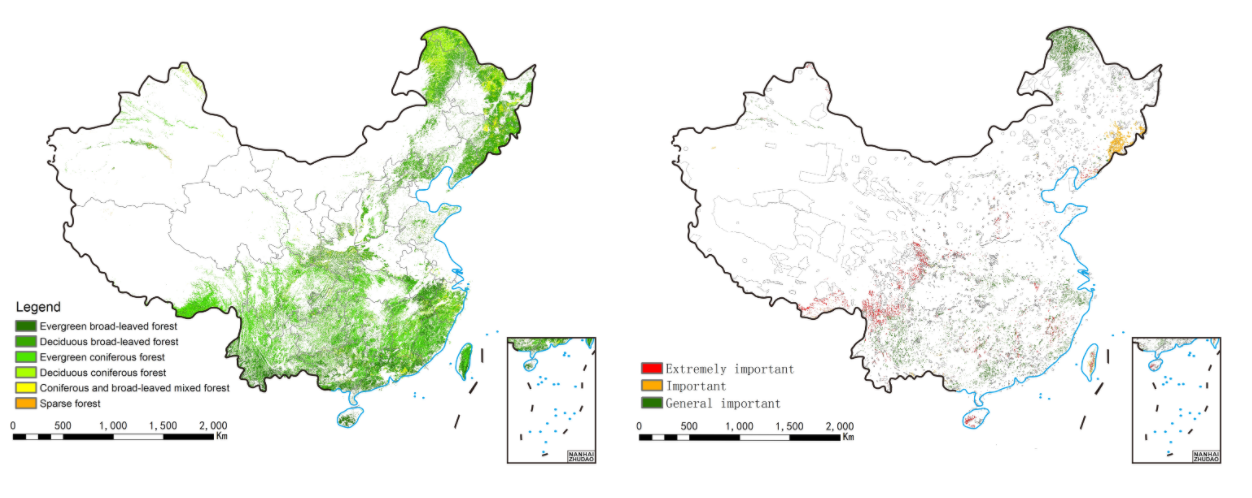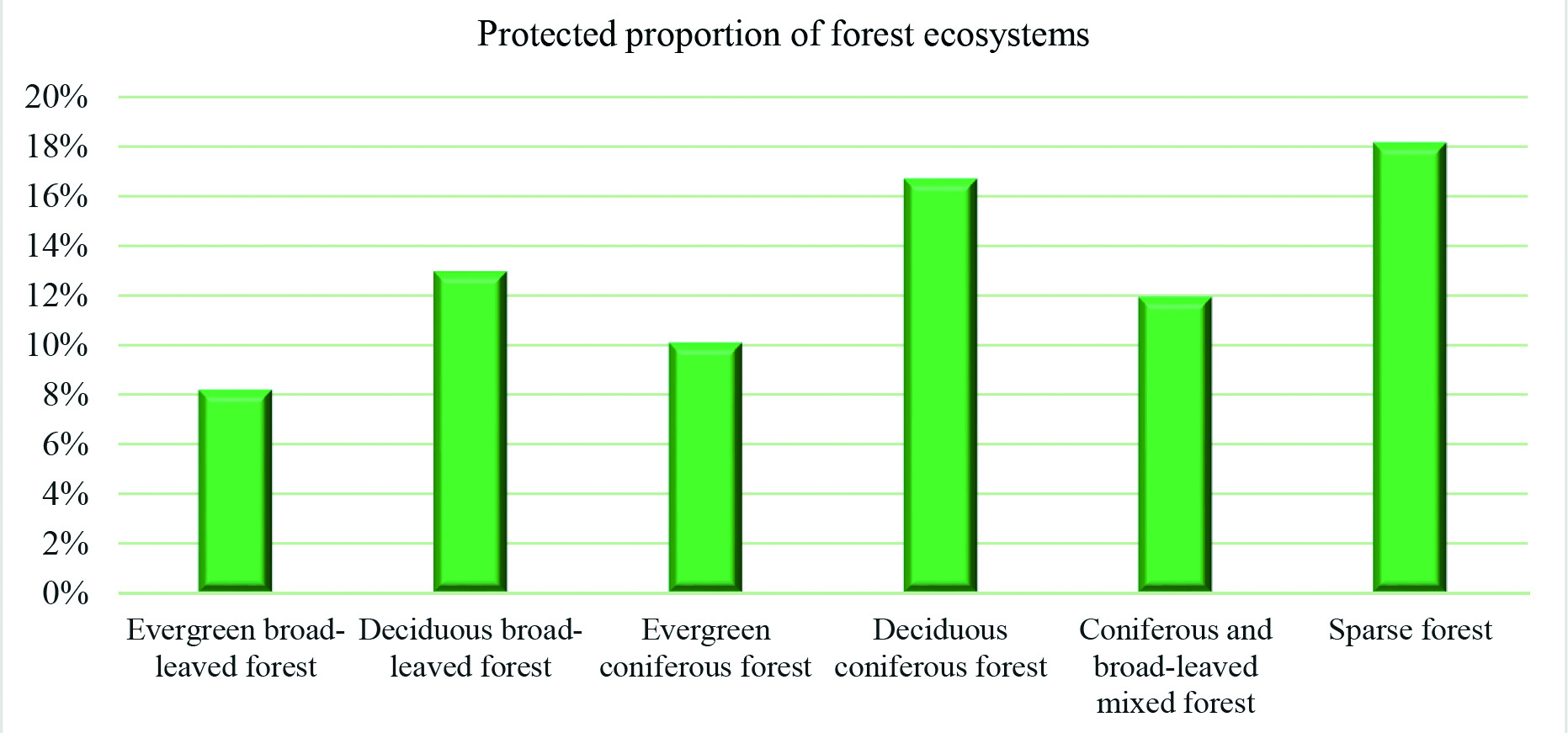SDG15: Life on Land
Study on forest protection proportion indicators(2019)
Scale: National



Study area: China
Forest ecosystems have an important role in maintaining biodiversity, ecological processes, and ecological function of natural ecosystems in addition to providing essential resources for human survival. The establishment of nature reserves is one of the most important ways to protect forest ecosystems. However, the status of forest ecosystem protection in existing nature reserves is unclear due to the lack of high-resolution distribution maps for various types of forest ecosystems. This report employs big data engineering to identify the spatial distribution of different types of forest ecosystems and their key protection areas and analyzes their protection in nature reserves.
SDG 15.1: By 2020, ensure conservation, restoration, and sustainable use of terrestrial and inland freshwater ecosystems and their services, in particular forests, wetlands, mountains, and drylands, in line with obligations under international agreements.
SDG 15.1.2: Proportion of important sites and ecosystems for terrestrial and freshwater biodiversity that are covered by protected areas.
Method
Object-oriented multi-scale segmentation and decision tree classification was performed using data from HJ-1A/ B and Landsat OLI (30-meter resolution) images to identify ecosystems. This method was supported using sample databases constructed from ground survey sites. The forest ecosystems were divided into four secondary subclasses consisting of coniferous forests, broadleaved forests, mixed coniferous and broadleaved forests, and sparse forests. This data also included six tertiary subclasses of evergreen broadleaved forests, deciduous broadleaved forests, evergreen coniferous forests, mixed coniferous and broadleaved forests, and sparse forests. However, these forest classifications were unable to meet the needs of ecological protection. Thus, a more detailed classification of the ecosystem was performed using the above results in combination with China's vegetation map, in which China's forest ecosystems were divided into 343 subclasses.
A series of indicators was selected to identify key protected areas in the forest ecosystems and their protection status. These indicators included endangerment, peculiarity, typicality, and integrity. These were then used to construct an ecosystem evaluation index system. The key ecosystems were further divided into three levels, including: extremely important, important, and generally important. Forest ecosystems and the key protected areas were superimposed with nature reserves, which provided the status of forest ecosystem protection in China. Lastly, areas with no protection were identified in the forest ecosystem.
Data used in this case
The data included environmental and disaster monitoring and forecasting using small satellite constellation (HJ-1A/B) and Landsat OLI (30-meter resolution) imagery. A 1:1,000,000 scale vegetation map was included, as well as spatial distribution data for the nature reserves.
Results and Analysis
The study found that the overall protection proportion in nature reserves for China's forest ecosystems was 11%, with a large variation among various ecosystem types. Under the six forestecosystem classification systems (Figure 1), the protected proportion was (in ascending order): evergreen broadleaved forest, evergreen coniferous forest, mixed coniferous and broadleaved forest, deciduous broadleaved forest, deciduous coniferous forest, and sparse forest. The protection proportion for evergreen broadleaved forests was less than 10%, while sparse forests had the highest values (18.2%) (Figure 2). Some of the 300 forest sub-types were totally protected, while others were unprotected. There was high variability in the proportion of forest ecosystem protection for different types of ecosystems. The results suggest the forests with lower protection proportions require additional protection.

Figure 1. (a) Distribution of different types of forest ecosystems, (b) Protection status of key protected areas in nature reserves.
The coverage rates are the most important indicators for protecting the key areas in forest ecosystems. The ratios for forests that were observed to have greater importance in nature reserves were 20.29%, 12.58%, and 11.53%, respectively. This indicates that forests that are more valued by society are better protected. However, there were still many conservation gaps in the northwestern part of Yunnan, southwestern Tibet, eastern Jilin, and northern Heilongjiang (Figure 1).

Figure 2. Conservation ratios for different types of forest ecosystems.

Figure 3. Purplecone spruce (Piceapurpurea, Wanglang Nature Reserve in Pingwu County, Sichuan Province, China).
| Highlights |
| Satellite remote sensing and Chinese vegetation maps can be integrated to reclassify Chinese forest ecosystems. The importance of forest ecosystems can be evaluated by selecting a series of indicators such as: "endangered” "endemic” "typical” and "complete". By analyzing with nature reserves, greater importance are better protected, but there are still significant protection gaps in some areas. |
Outlook
In future studies, remote sensing spectral information and existing forest ecosystem distribution information should be fully considered to further improve the classification accuracy for various types of forest ecosystems. Moreover, this information should be used to identify the protection status for key areas, and to provide methodological and data support for accurate assessment of forest ecosystems.
This study can provide scientific support for optimizing spatial distribution of natural reserves and improving the efficiency of forest ecosystem protection in China. Furthermore, the concepts and methods provided by this study might serve as a useful reference for similar work, and for promoting conservation of global forest ecosystems.

